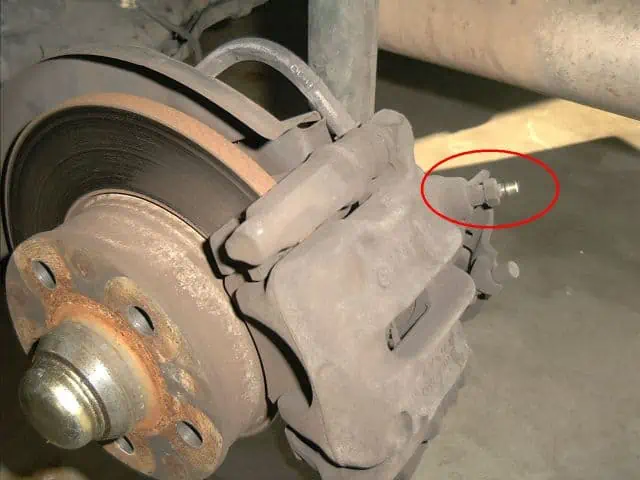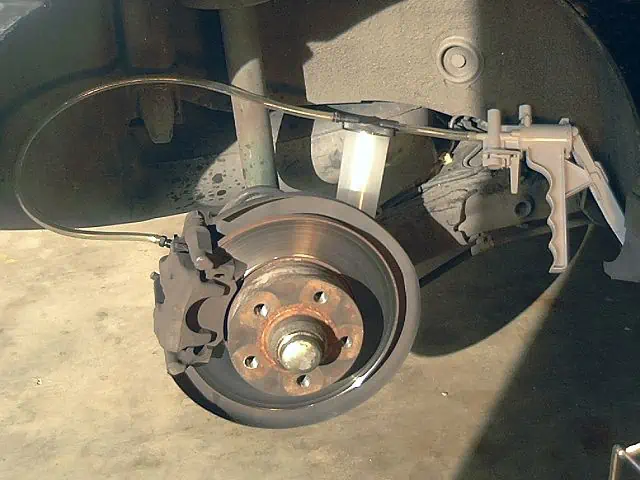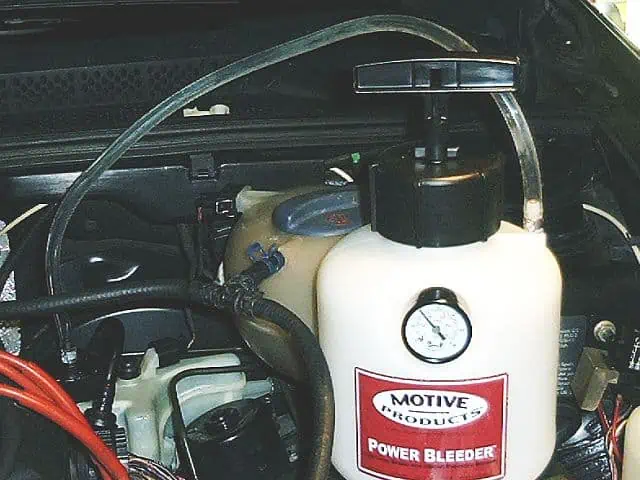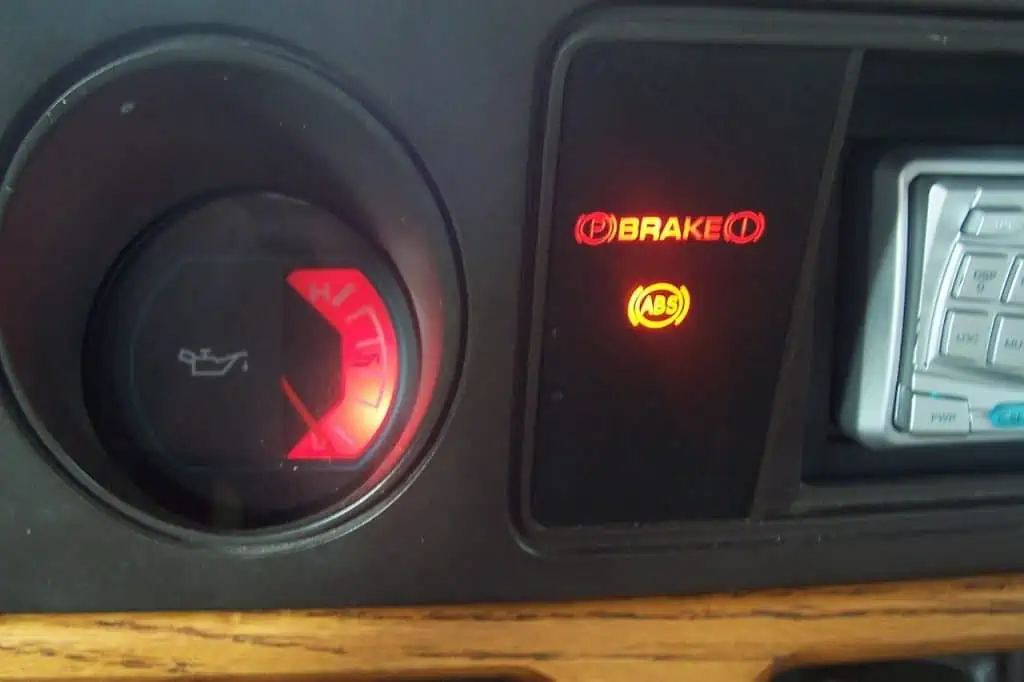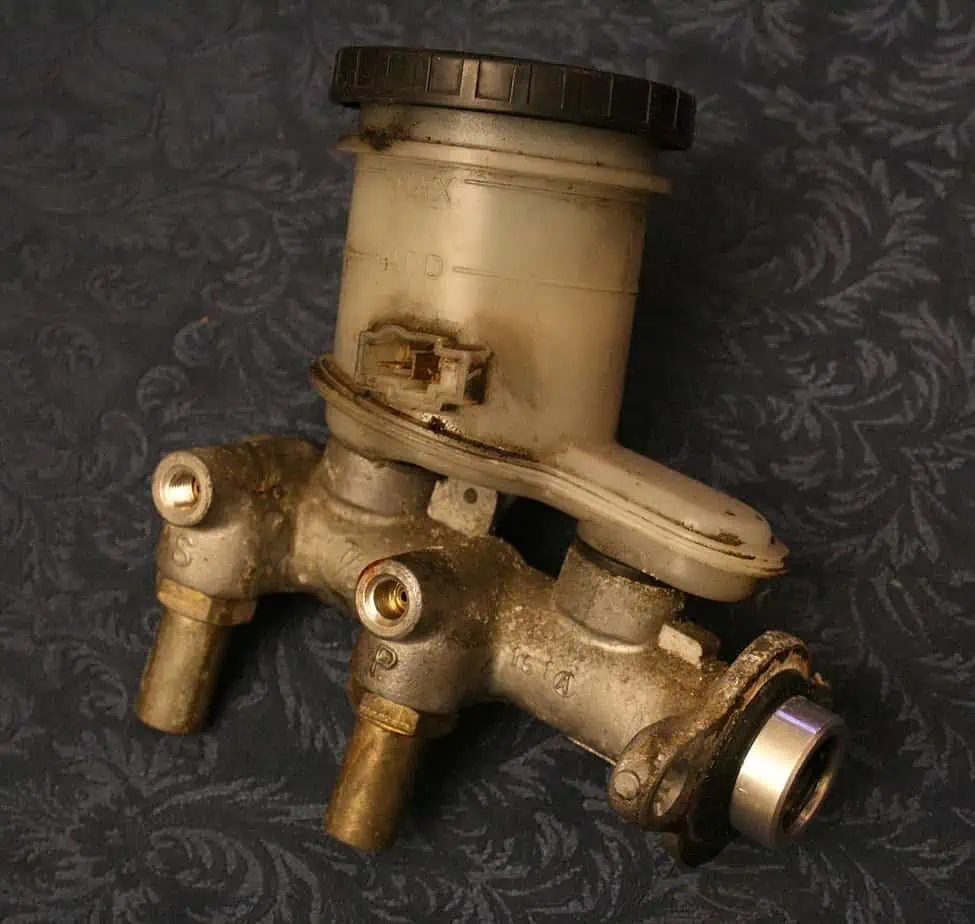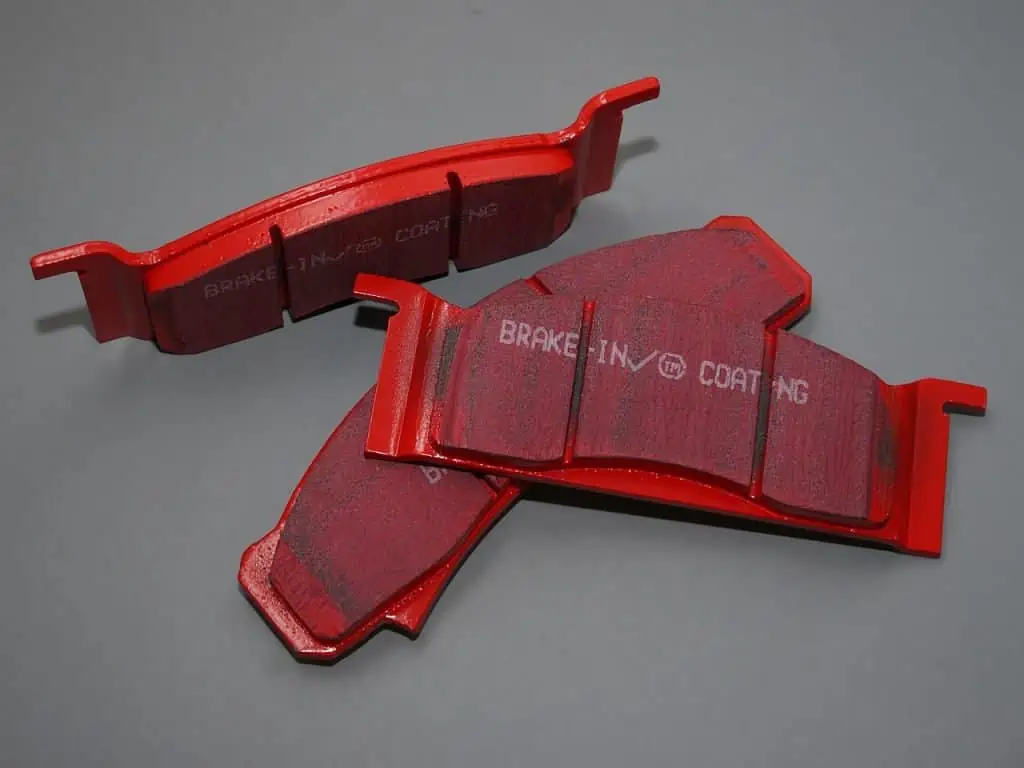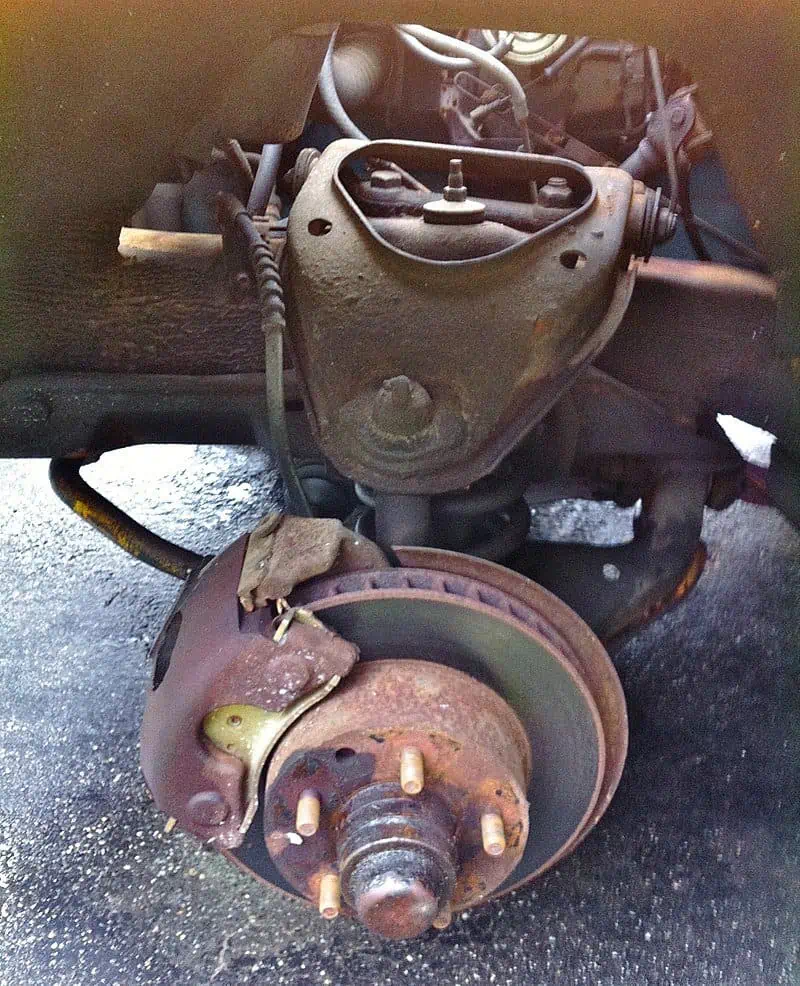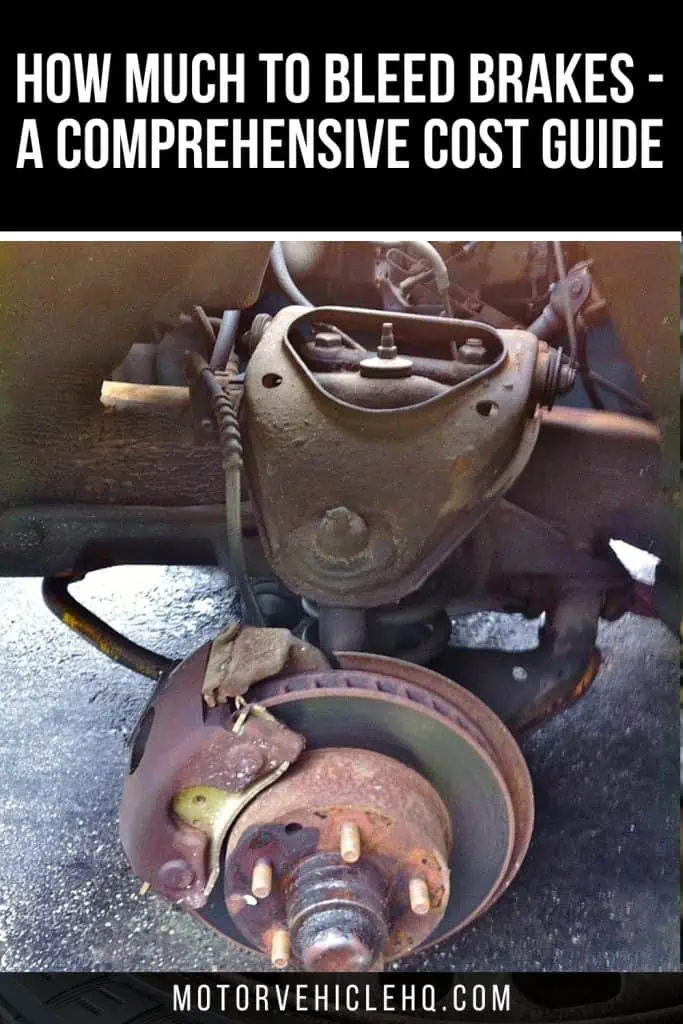Although bleeding your brakes may seem frightening, it is simply basic maintenance that keeps your brake system functioning correctly. You must make sure that the pressure in your brake lines is perfectly controlled because your brakes are a hydraulic system.
As you press down on the brake pedal, your ability to stop your automobile safely will be impacted if moisture or air enters the lines. The brakes are at the top of the list of automotive systems that you don’t want to take any chances with.
Fortunately, getting your brakes bled is not only quite inexpensive but also a standard maintenance task. The typical cost of having your brakes bled by a professional is between $75 and $100.
The price of having your brakes bled will vary somewhat depending on the year, make, and model of the car you drive as well as the location where the work is done.
As most of us are aware, repairs at a dealership are frequently more expensive than repairs at a mechanic. And if you have the knowledge and resources to complete the task yourself, it will always be less expensive than hiring a mechanic.
The labor costs incurred rather than the parts themselves make up the majority of the expenditures connected with having a mechanic work on your car. Depending on the job, the labor component of what you pay a mechanic often makes up around two-thirds of the total cost.
For this type of job, higher-end vehicles will typically cost you more than a more affordable car. For instance, you might anticipate paying between $125 and $175 to have the brakes bled on an Audi A4.
Although it’s not a tremendous rise, it is enough of an increase. On the other hand, if you drive a Honda Accord, it might only cost you $60 to $75 to have your brakes bled.
Some of you might not be familiar with the procedure, of course. The following information will teach you how to properly bleed your car’s brakes:
A Close up of a disk brake bleed screw by File Upload Bot (Magnus Manske). Although bleeding your brakes might seem scary, it is routine maintenance that keeps your brake system working properly. Because your brakes are a hydraulic system, you must make sure that the pressure in your brake lines is precisely managed. If air or moisture gets into the brake lines, it will make it harder for your car to stop safely as you apply the brakes.
How the Brake System In Your Car Operates
It’s vital to comprehend how your car’s braking system functions to grasp why you need to bleed the brakes on your vehicle. Naturally, if you are already familiar with how it operates, you may skip the entire section. Nonetheless, for those of you who are unaware, here is how it operates:
There are various kinds of braking systems, however, hydraulic systems are most frequently used in automobiles. This is probably what your car utilizes. Although the system includes many parts, we may divide them into a few major ones:
- The brake booster
- The master cylinder
- The brake fluid
- The brake lines
- The brake pads and calipers
- The Rotors (or the drums as referred to in some vehicles)
So how do they function? In your car, the process begins when you depress the brake pedal, which triggers the brake booster and increases the pressure.
In turn, the master cylinder transforms mechanical pressure into hydraulic pressure, which pushes braking fluid in a specific direction. The brake lines, which are typically a rubber hose connecting the master cylinder to the unique brake system in each wheel, are then used to transport the brake fluid.
The calipers will experience pressure when the braking fluid gets there. As a result, the brake calipers and the brake pads inside of them will make contact with the rotors.
As a result, unless you release pressure from the brake pedal, the rotors will slow down and your wheels will slow down as well.
Drum brakes also work with a hydraulic system. The only distinction is that they deliver pressure from inside the drum, not from the outside, to the brake shoes (pads).
It seems rather straightforward, doesn’t it? As previously indicated, the system also includes additional parts like the ABS and wheel speed sensors, although these are unrelated to the subject at hand.
Which are the Different Kinds of Brake Systems?
The only system that occasionally requires bleeding is the hydraulic braking system. Other braking systems are therefore not pertinent to our discussion. To ensure that you are aware of them, we will simply quickly describe them. Two further kinds of braking systems are as follows:
1. System of Electromagnetic Brakes
This method electronically controls your wheels while using magnets to slow them down, as the name would imply. The C8 Corvette, Lexus RX400h, and Toyota Prius are a few vehicles that make use of technology. These might also be referred to as the brake-by-wire system.
2. System of Mechanical Brakes
Instead of a hydraulic system, this technique applies pressure to the calipers by mechanical linkages like rods or springs. Typically, this is how the hand brake or emergency brake is operated.
Vacuum bleeding a disk brake caliper by File Upload Bot (Magnus Manske). Bleeding the brakes will keep the braking system in good condition and keep you safe. To release any moisture or trapped air in the brake lines, your car’s brakes must be bled. When there is air or moisture in the brake lines, the flow of the braking fluid is interfered with. If the fluid isn’t flowing properly, the hydraulic pressure throughout the system will decrease.
So now you are aware of how the hydraulic system and other braking systems operate. But why is it necessary to bleed the hydraulic system? That leads well into the following section:
How Much to Bleed Brakes: Why Is It So Important?
As previously said, bleeding your brakes will maintain the health of your braking system and keep you safe. So why precisely is that? The major purpose of bleeding your car’s brakes is to get rid of any moisture or trapped air in the brake lines.
The flow of braking fluid is disrupted when there is air or moisture in the brake lines. The system’s overall hydraulic pressure will be reduced if the fluid isn’t flowing properly.
In the end, this will lead to less braking force, which might reduce the efficiency of your brakes and lengthen the stopping distance of your vehicle.
In extreme circumstances, the brake fluid might never even get to the calipers. This effectively renders your brakes inoperative because your calipers won’t lock onto the rotors.
This is as good a reason to bleed the brakes as any because, unlike you, I like my brakes to function while I’m driving.
Here’s a hint: pump the brake pedal several times if your brakes don’t engage when you press the pedal. In doing so, the brake fluid will have an easier time getting to the calipers and working.
After around three pumps, the pedal should be under pressure. Pump the pedals once more if the pressure is gone.
It should go without saying that you should visit a repair shop as soon as you realize there is a problem with the brakes and have it fixed. Even if you can pump the brakes, it won’t be long before they quit functioning altogether.
How Can Air Get Into the Brake System?
The braking system has an airtight construction. Yet, there may be instances where air can get inside it, such as when you change the brake pads in the calipers. When you open the reservoir for the braking fluid, it could also enter the system.
Since the brake system is closed, it is not essential to top it off. Unless, of course, you enter the system through leaks.
Thus, keep the brake fluid reservoir closed to keep moisture and air out. In most cars, the reservoir is located close to the firewall. It features a black cap with a yellow emblem for the emergency brake on it.
You can also have a leak in one of the braking lines. In addition to letting brake fluid escape, which will diminish the efficiency of the brakes, this leak will also let air in, which will make things worse.
When Should You Bleed Your Brakes?
When it comes to when you should get your brakes bled, just like with most maintenance and repair tasks, your manufacturer should give a specific number you may use as a guide.
Pressure bleeding a brake system by Mcapdevila. The car’s brakes shouldn’t need to be bled, and it shouldn’t cost more than $150. Most cars typically cost between $110 and $150. The labor will cost you roughly $90, and the additional $20 will be spent on the new braking fluids you must add to the system. Understandably, some cars may cost more than others, especially luxury and performance cars.
A decent rule of thumb is to leave the system around every 30,000 miles to make sure everything is functioning as it should.
But, that is the number for routine maintenance, and there are some warning signs and symptoms you can watch out for to let you know you need to get your brakes bled before that time.
Take your car to a repair if you notice any of these symptoms so they can examine it and determine whether you need to bleed your brakes.
The first reason you need to get your brakes bled is because air bubbles are beginning to form in the line, which will make it harder for your brakes to function as they should. When brake fluid boils and produces steam, the air becomes trapped in the brake lines.
This steam is squeezed back into the water as your hydraulic brakes continue to work, but as it does so, it separates the air from the water. This produces tiny air bubbles that, with time, can grow into larger ones and air pockets.
1. The Brake Pedal Provides a Spongy Feeling on Touch
Continual pressure should be felt when applying the brakes. A spongy brake pedal is what we refer to when there is inconsistent pressure. To apply the brakes, you frequently need to press the pedal firmly.
This is the primary indication that the braking system needs to be bled because air has gotten into the brake lines.
2. There Is a Brake Light On
Your dashboard should contain a brake indicator light that alerts you to any problems with your braking system, similar to a check engine light.
It will either be red or yellow, and it might read ABS or something different, but it’s a good indication that your computer has detected a problem and that your car needs to be inspected.
3. A Not Sharp Brake Pedal
For drivers who have never had this experience before, it can be difficult to explain. The brake pedal seems somewhat like it is made of a sponge or another soft and squishy material when your foot is on it.
They won’t be as firm and taut as the brakes you formed to function regularly. When you need to stop, it will feel like you have to apply pressure to the brakes for a longer period and with greater force.
Generally, this results from the brake lines having some air in them. As a result, to get your brakes to stop, you will need to exert more force and maintain it for a longer period. Even worse, until you fix the issue, it will probably persist and probably get worse over time.
4. Brakes Needing Continuous Pumping
Generally, you should just press down with your foot until your car comes to a stop. Another indication that you may have some air in the brake line is if you notice that you have to pump the brakes rather than simply maintain pressure on the pedal to stop your automobile.
This happens because air causes the hydraulic system’s pressure to fluctuate. Because of the bubbles, the hydraulics are unable to consistently depress the brakes, thus you must continuously pump the brake pedal to get the brakes to engage and stop your automobile.
A brake malfunction warning light by Ahanix1989. Similar to a check engine light, the dashboard should have a brake indicator light that warns you of any issues with your braking system. It might say ABS or something else, and it will either be red or yellow, but it’s a positive sign that your computer has identified a problem and that your car needs to be serviced.
5. Absolutely No Pressure or Resistance to Braking
It is simple to confuse this with a just soft or spongy brake pedal, but this is not the same thing. When the spongy brake pedal is malfunctioning, there is still some resistance, but it is soft.
When there is no resistance at all, you can put your foot on the brake in this situation, and the vehicle will immediately stop as if there were no connection at all.
Your brakes are probably not working at all and you have a lot of air in the brake lines if there is no resistance when you apply the brakes. Your brakes won’t activate if you can press the brake to the floor without experiencing any pushback, which could place you in a very risky situation.
If this has ever happened to you and your brakes aren’t responding to you, you must proceed with extreme caution.
A mushy brake pedal is far less severe than what is experienced here. No matter how hard you press the pedal in this situation, you won’t experience any pressure or resistance. A significant volume of trapped air can also be the cause of this, in addition to a leak or other systemic issue.
What Should You Do If the Brakes Don’t Provide Any Resistance?
You should make an effort to maintain composure if your brakes fail while you are driving since you run the risk of seriously hurting both yourself and other people.
If at all possible, you should downshift to a lower gear in this circumstance. To alert other drivers of a problem, turn on your four-way flashers.
See if you can create any pressure by pumping your brakes. You might be able to remove part of the air from the line and restart the hydraulics. If you give it a few tries and nothing happens, try putting your foot on the parking brake.
Driving while applying the parking brake can be risky, but it’s far safer than doing so while using no brakes at all. You can try to carefully move to the roadside shoulder by applying the parking brake.
Keep an eye on the cars surrounding you because if you come too close to them, they’ll expect you to brake as usual and there won’t be any other way to let them know there’s an issue other than your flashing lights.
It will require cautious driving and some effort to stop your car if your parking brake isn’t working, which is also a possibility, or if you’re on a highway. Make careful to let off the throttle so that you can coast and, preferably, lose speed.
In severe situations, such as when you’re moving at a very high rate of speed or when your speed is declining but you’re increasing it, you might need to take drastic action.
It’s feasible to very slowly and delicately maneuver your vehicle towards a guardrail or median wall if one is present such that you begin grinding against its side.
The alternative could be disastrous for you and other motorists on the road, but doing this would seriously harm your car. Only carry out this action in the direst situations when it’s secure for you to do so.
If your brakes have failed, you must remain calm and aware of your surroundings. When you can, use the terrain’s natural features to assist you in safely slowing down, and try your hardest to stay as far away from other vehicles as you can.
A car brake system master cylinder by Specious / CC BY-SA 4.0. Braking fluid is pushed in a certain direction by the master cylinder, which converts mechanical pressure into hydraulic pressure. Then, the brake fluid is transported by the brake lines, which are ordinarily rubber hoses linking the master cylinder to the specific brake system in each wheel. When the braking fluid reaches the calipers, pressure will build up there.
NOTE: If there is air in the system, the check brake lights won’t come on, so you’ll need to pay attention to how well your car brakes to know when to bleed the brakes.
However, a reduction in stopping power should not be ignored. These are some additional instances where we advise bleeding the system, in addition to the warning signs:
- A leak has been found in the system. You’ll also need to replace the leaky component in this situation.
- After performing other braking system maintenance or repairs, such as changing the brake pads.
- As preventive maintenance, once a year.
That concludes the discussion of the braking system. everything from how it functions to why and when the brakes need to be bled. Let’s now examine the cost in more detail:
How Much to Bleed Brakes?
As previously noted, bleeding the brakes on your automobile shouldn’t set you back more than $150. Typically, most autos cost between $110 and $150.
The work will run you about $90, and the new braking fluids you’ll need to add to the system will cost you about $20 more. Naturally, certain vehicles may be more expensive, particularly luxury and performance vehicles.
Can I Perform Brake Bleeding on My Own?
Although it’s not too expensive, can you do it yourself to avoid paying for labor? You can, but we must caution you that if you’re not mechanically inclined, it might be challenging.
Also, the brake system is essential for your safety when driving, so if you’re unsure, we don’t advise you to perform any DIY safety fixes.
In my opinion, it’s best to let a pro do this task. I once attempted to do it on my own, but I found the procedure to be tedious and would have preferred to have someone else handle it.
Anyway, you’ll need a companion to assist you if you want to do this on your own. You’ll also require the following items:
- A turkey baster
- A wrench with an open end.
- A hose and an empty bottle
- Check your owner’s manual to find the proper fluid for your vehicle when purchasing new brake fluid.
Here are the procedures to bleed your brakes with the items mentioned above in hand and a friend by your side:
Brake Bleeding Techniques: How Is the Whole Procedure Done?
The type of house repair you could handle yourself is a brake bleed if you’re interested in doing it yourself to save a little money.
A set of high-performance brake pads by Treemonster86 / CC BY-SA 3.0. The braking system is built with sealed materials. Yet, there might be times when air gets within it, such as when you replace the brake pads in the calipers. It might potentially enter the system if you access the brake fluid reservoir. The brake system is closed, therefore topping it off is not necessary. Except if you get in through leaks, of course.
Even though it won’t cost you much to hire a professional to handle this task and because your brakes are such a crucial component of your vehicle, you might not want to take any chances if you’re new to DIY car repair.
Make sure you have the proper type of brake fluid on hand before doing this task on your own. This is one of the most crucial considerations. Regrettably, there is no universal standard for any type of fluid for your car.
There are numerous formulations for brake fluid, coolant, and motor oil. As a result, combining one type with another can effectively destroy the entire system.
Make sure you’re using the proper fluid in your brake lines to avoid having to flush and fix the entire line before it can function properly. To ensure that you don’t use the incorrect thing, consult your owner’s manual or have a mechanic check it out for you.
If you’ve never bled brake lines on your own before, you can find many helpful videos on the internet that will walk you through the process step-by-step so you can see exactly what you need to do.
After you know you have what you need. If you can watch a pro perform it and demonstrate what needs to be done, it makes it much simpler to do the task for the first time.
- Take the wheels off of your car and place them on jack stands. Although it’s not necessary, doing this will make it much simpler to access the bleeder valves.
- Find the bleeder valve, take off the rubber cover, and attach your hose to it.
- Then, drain as much fluid as you can from the master cylinder. To locate the master cylinder, consult your owner’s handbook. Open them, then scoop them out with a turkey baster and place them in the empty bottle.
- Put the fresh brake fluid in the master cylinder.
- You’ll need a companion to depress the brake pedal at this point. Tell your companion to depress the brake as you open the valve.
- Tell them to release the brakes and close the valve. Many times, go through this process.
- Check the master cylinder’s fluid level and the fluid in the bleed pipe about every five pumps. If more fluid is required, add it to the master cylinder. Moreover, make sure the fluid in the bleed pipe is clean and free of air bubbles before moving on to the other wheels. Once you’re finished, put the bleeder valve’s rubber cover back on.
- Repeat steps 2 through 7 for the following line.
- Check the fluid level at the master cylinder once you’ve finished bleeding all the lines. Fill it up with fresh fluid until the maximum indicator is reached.
- You’re finished! Test the brake pedal after starting the vehicle; if there is pressure, everything is in working order.
The front suspension and brake system by CZmarlin / CC BY-SA 3.0. The brake system is closed, therefore topping it off is not necessary. Except if you get in through leaks, of course. Keep the brake fluid reservoir sealed to prevent air and moisture from entering. The reservoir is typically found close to the firewall in autos. It has a black cap with a yellow emergency brake logo on it.
What Can Happen If You Do Not Bleed the Brakes?
If you wait to have your brakes bled after noticing some of these signs, the outcome will be unpredictable braking and possibly no brakes at all.
Although the air in your brake lines won’t get better on its own, the longer you allow any of these symptoms to persist, the worsening they are likely to get. If you let this persist without being rectified for a while, it will be nearly impossible to avoid an accident.
How Can I Keep My Brakes In Good Condition?
You can’t do anything to increase the lifespan of your braking rotors and pads. But here are some things you should do to keep the system functioning as a whole:
- Once a year, check the brake pads, calipers, and rotors. During a significant service, ask your mechanic to check them if you’re unsure about what to do. They’ll be able to let you know how your brakes are doing.
- Pay close attention to how you brake and the pedal. Find the issue and fix it to stop any additional harm if they feel spongy or off in any other way.
- Avoid abrupt, harsh braking; it will quickly wear down your brake pads and rotors. To coast and gently apply the brakes, maintain a safe distance from the vehicle in front of you.
That’s pretty much it; there is nothing else you can do to protect and lengthen the lifespan of your brake system.
The Conclusion
You should never take any chances with your brake lines, as we previously stated. You may safely put off thinking about a failing system like your car’s air conditioner for a time, but you never want to do that with your brakes.
When you discover that your brakes seem spongy or aren’t restraining your foot as they should, you put both your safety and the safety of others at risk.
Beyond how the brake pedal feels, there aren’t many warning signals that you may watch out for that would indicate an issue with your brake fluid line.
Your brakes will either function properly or they will begin to fail, and when that happens, it may be frightening for a motorist. You should take your vehicle to repair as soon as you become aware of a braking issue to prevent the issue from getting worse.
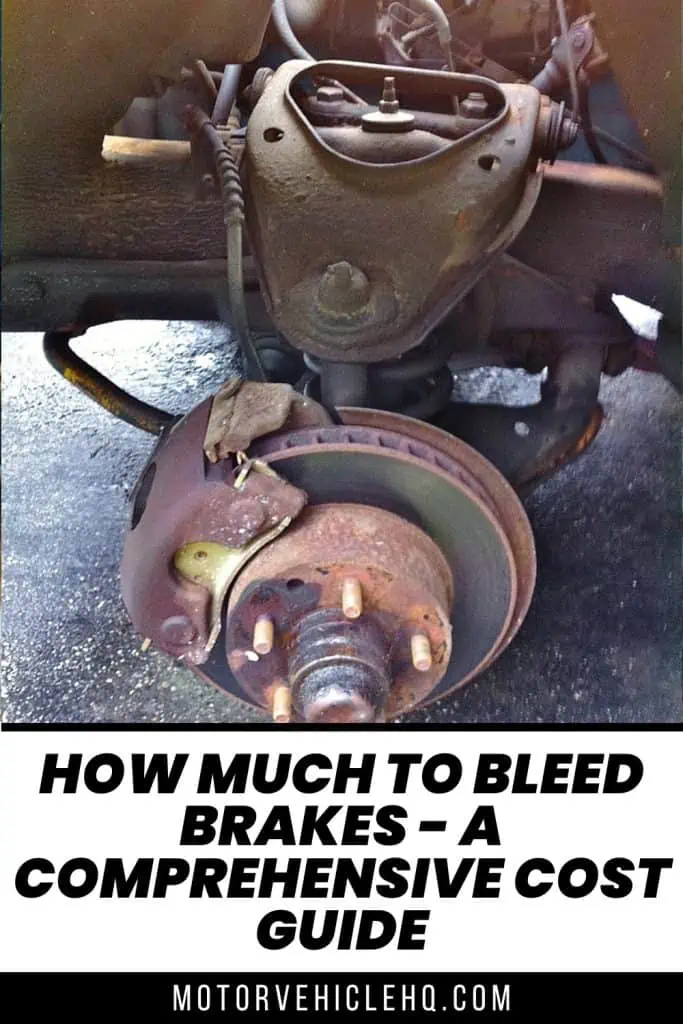
The front suspension and brake system by CZmarlin / CC BY-SA 3.0

Jim Wicks is the founder of MotorVehicleHQ. With over two decades of experience in the automotive industry and a degree in Automotive Technology, Jim is a certified car expert who has worked in various roles ranging from a mechanic, car dealership manager, to a racing car driver. He has owned more than 20 cars over the past 15 years. Ask him about any vehicle you see on the road and he can tell you the make, model and year. He loves the aesthetics of all things cars, and keeps his vehicles in pristine condition.
In his free time, Jim enjoys getting his hands dirty under the hood of a classic car or taking long drives along the country roads. His favorite car? A 1967 Shelby GT500, a true classic that, according to Jim, “represents the pure essence of American muscle.”
